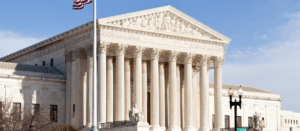Any time any law seeks to put any limits on abortion, Planned Parenthood is guaranteed to sue. It is something with which legislators have to deal. No matter how reasonable the law is, the nation’s largest abortion provider’s existential dependence on public funding for their promotion of abortion makes them rabid in their attack on any efforts to reasonably limit the heinous practice.
But thanks be to God that today, the United States Supreme Court (6-3) dealt a big blow to their ability to take legislatures to court when they try to promote life-affirming healthcare instead of abortion’s deathly ramifications. The case is Medina v. Planned Parenthood South Atlantic.
The case involves a South Carolina statute that prohibits the use of taxpayer funds to pay for abortions. As a result of the law, the state deemed pro-abortion Planned Parenthood facilities unqualified to receive Medicaid funding if they continued performing abortions. The state sought to redirect the money to other facilities that provide life-affirming care for low-income women.
But Planned Parenthood predictably sued and promptly obtained an injunction to stop South Carolina from focusing on saving lives instead of ending them. The district court ruled in their favor, and the Fourth Circuit affirmed. The Supreme Court has reversed their actions today, allowing the law to be enforced going forward.
Beyond the fact that Americans should not be forced to pay for abortions and fund organizations that perform and promote abortions and that distribute dangerous gender-transitioning drugs, as Concerned Women for America (CWA) has constantly exposed, the Court reasonably said it is a matter of separation of powers. Planned Parenthood cannot sue the state because the law does not allow it, and the Courts cannot rewrite the law.
Justice Neil Gorsuch, writing for the majority of the Court (including Chief Justice Roberts and Justices Clarence Thomas, Samuel Alito, Brett Kavanaugh, and Amy Barrett) said, “Deciding whether to permit private enforcement poses delicate policy questions involving competing costs and benefits—decisions for elected representatives, not judges.”
He explained that “it is rare enough for any statute to confer an enforceable right, spending-power statutes like Medicaid are especially unlikely to do so.”
The majority stays away from the dissenting justices’ (Justices Ketanji Brown Jackson, Sonia Sotomayor, and Elena Kagan) invitation to stray away from the statute in question, in search of a more amenable policy outcome. They suggest looking at legislative history. To which the majority answers, “When it comes to interpreting the law, speculation about what Congress may have intended matters far less than what Congress actually enacted.”
The dissent, following Planned Parenthood’s arguments, suggests Congress modeled the statute in question here after another titled “Free choice by patient guaranteed.” Just think of it – finding no support in the actual text, they would go to another statute that does not apply to find support for their arguments. Thankfully, the Court easily dismisses it.
The other side also suggests the Court’s test for finding a private right of action should be rewritten to include “whenever it uses ‘compulsory’ and ‘individual-centric terminology,’” as long as it evokes “language classically associated with establishing rights.” The living-constitutionalists always prefer ambiguity in law that allows them to find the preferred outcome on each case. Once again, though, the majority was not biting. “Our precedents do not authorize anything like the dissent’s approach—and for good reasons.” The Court criticizes the dissent’s reliance on “unspoken judicial intuition,” that “would leave the States guessing about the terms of their deals with the federal government and invite courts to revive their long-abandoned approach of usurping Congress’s role in creating rights and remedies.”
Finally, the dissent is simply not satisfied with letting the federal government handle compliance as outlined in the statute. It suggests it has “neither the capacity nor the appetite for taking that ‘drastic step.'” Again, Justice Gorsuch writes clearly, “This Court has rejected the notion that funding cutoffs are ‘too massive’ to be realistic relief. Alternative enforcement exists—States have administrative processes for provider challenges, reviewable by state courts. If existing remedies prove insufficient, Congress can create new ones. But balancing enforcement costs and benefits is a policy question for Congress, not courts” (Internal citations omitted).
Though procedural in nature, this is a landmark case for the cause of life that will allow states to enact pro-life legislation that takes money away from pro-abortion promoters and allocates it toward life-affirming healthcare providers that better serve the needs of mothers and their children.






